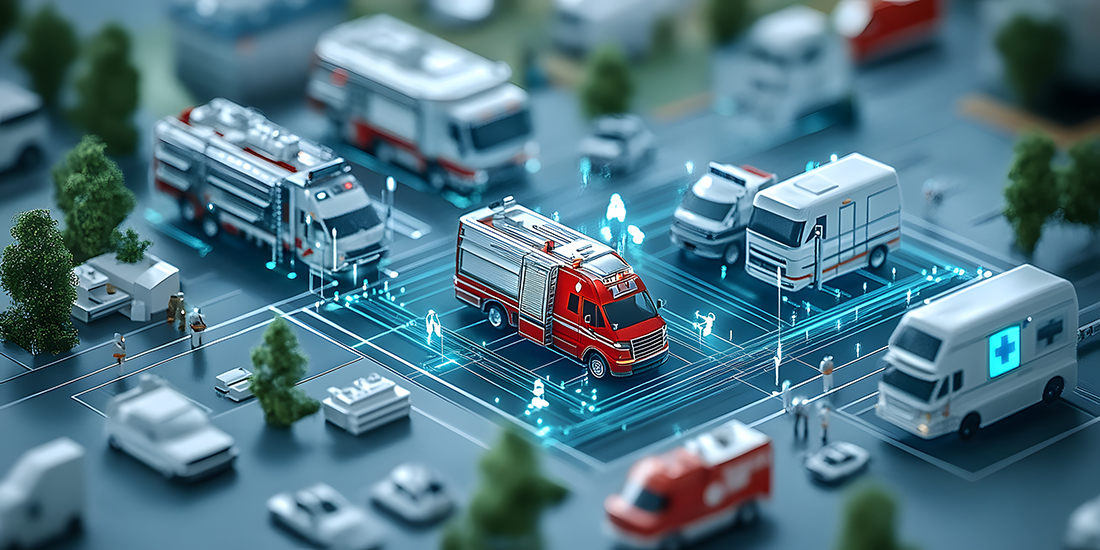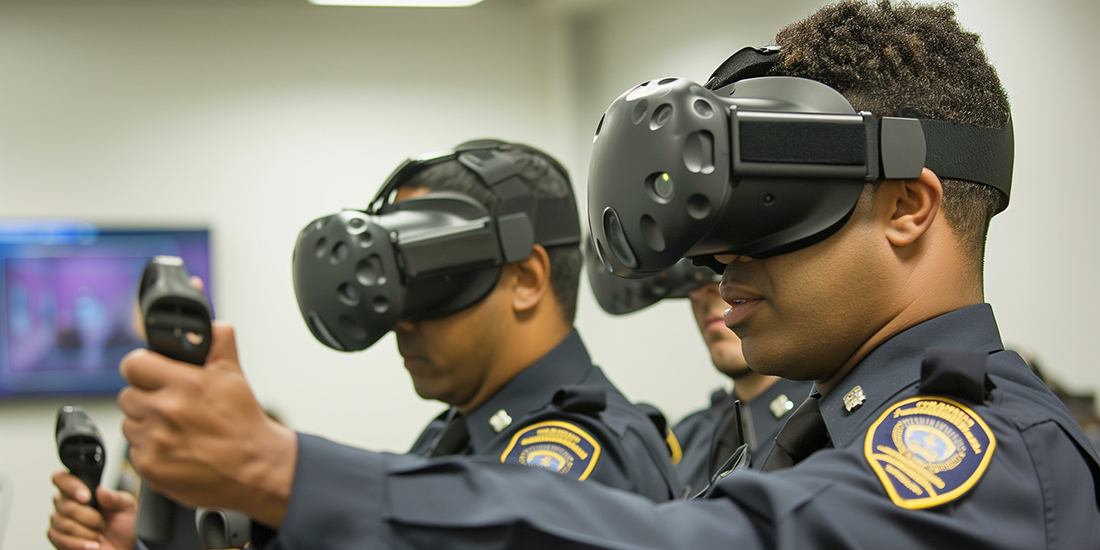Most recently published

Editor’s Note – Protecting Food and Agriculture: Bigger Than Rising Egg Prices
Catherine L. Feinman
March 26, 2025
The authors in the March 2024 edition of the Domestic Preparedness Journal share their expert insights on topics that may be overlooked by nonrural communities and why common agricultural and critical infrastructure operations should be on the minds of any emergency preparedness professional.

Farm to Power: New Hazards in Rural Communities
Russ Kane
March 26, 2025
In the interest of reducing methane pollution and establishing a revenue stream for a renewable resource, dairy and livestock operators are creating mechanisms to produce compressed natural gas. This new technology reduces greenhouse gases but also introduces new hazards to rural communities.

Podcast – Advisory Board Spotlight: Interview With Anthony Mangeri
Anthony S. Mangeri
March 19, 2025
Anthony Mangeri is an educator and seasoned leader in emergency management. He is the chief operating officer of the Mangeri Group and the immediate past president of the International Association of Emergency Managers (IAEM) Region 2. Learn about Anthony’s passion for his field and for the Domestic Preparedness Journal.

Agricultural Supply Chain Vulnerability: A Freight Rail Disruption Case Study
Michael Sharon and Randy Treadwell
March 19, 2025
The agricultural supply chain’s global interdependency introduces considerable vulnerability. The failure or weakening of even one of the supply chain links has cascading effects. Awareness of potential catastrophe across sectors is crucial to emergency preparedness.

Agroterrorism: A Persistent but Overlooked Threat
Dan Scherr and Tanya M. Scherr
March 19, 2025
Agroterrorism is not new. Considered a subset of bioterrorism, it has become an increasing concern to the U.S. With so much of the agriculture sector in private hands, preparedness leaders must take extra steps to engage stakeholders and incorporate them into planning efforts.

The Societal and Economic Dangers of Agroterrorism
Michael (Mike) Nicholls
March 12, 2025
While Ireland’s potato blight was destructive to the Irish population, modern agroterror attacks could be designed to hurt a nation’s economy rather than to kill its people. However, positively identifying agroterrorists would be a formidable task.

Cost Analysis: Protecting the Grid and Electronics from an EMP
The Foundation for Infrastructure Resilience
March 12, 2025
Because modern societies are increasingly reliant on electronics, they are more vulnerable to the effects of an electromagnetic pulse event. As nations move to electrify their critical infrastructure and essential services, the cascading effects of a power grid disruption increase their vulnerability.

Beyond the Showcase: Strengthening Biosecurity at Livestock Exhibitions
Joshua Dise
March 5, 2025
Hazards and risks associated with state and local fairs mirror those of other high-attendance events—medical emergencies, mass casualty incidents, and other public safety risks. However, within the food and agriculture sector lies an additional risk: the spread of animal diseases, which can have catastrophic consequences.

The Human Factor in Cybersecurity Events: Critical Education Components
Dan Scherr and Tanya M. Scherr
March 5, 2025
When considering cyberattack risk, understanding the primacy of the human factor is central in developing plans for continuity of operations and incident response. With the increasing cost of data breaches, it is increasingly important to educate users on best practices and to employ robust security programs.

Editor’s Note: Maximize Training, Minimize Risk
Catherine L. Feinman
February 26, 2025
The December 2024 edition of the Domestic Preparedness Journal provides insight into the intersection of AI and emergency preparedness. With their exponentially increasing speed of development, existing, emerging, and not-yet-created technologies must all be part of the planning process in 2025 and beyond.

Emergency Management has Evolved: Why the All-Hazards Era is Over
Chas Eby
February 26, 2025
While initially useful, the term “all hazards” no longer accurately describes the functions or mission of the emergency management discipline. The current generation of emergency management has moved beyond all hazards to become “hazard agnostic.”

Elevating Law Enforcement Training Standards
Richard Schoeberl and Anthony (Tony) Mottola
February 26, 2025
Training standards ensure that all law enforcement officers receive a consistent level of knowledge and skills to perform their jobs safely and effectively. One training model incorporates “pracademic” professionals and garners trust from practitioners as well as academics. Its integration of theory and practice sets a training standard that can

Agriculture Security: Systems-Based Preparedness
Joshua Dise and Adrian Self
March 26, 2025
As economies and populations grow, the food and agricultural security is of increasing concern. This demands proactive investment in risk management and security measures to ensure the sustainability of the global food supply.

Editor’s Note – Protecting Food and Agriculture: Bigger Than Rising Egg Prices
Catherine L. Feinman
March 26, 2025
The authors in the March 2024 edition of the Domestic Preparedness Journal share their expert insights on topics that may be overlooked by nonrural communities and why common agricultural and critical infrastructure operations should be on the minds of any emergency preparedness professional.

Farm to Power: New Hazards in Rural Communities
Russ Kane
March 26, 2025
In the interest of reducing methane pollution and establishing a revenue stream for a renewable resource, dairy and livestock operators are creating mechanisms to produce compressed natural gas. This new technology reduces greenhouse gases but also introduces new hazards to rural communities.

Podcast – Advisory Board Spotlight: Interview With Anthony Mangeri
Anthony S. Mangeri
March 19, 2025
Anthony Mangeri is an educator and seasoned leader in emergency management. He is the chief operating officer of the Mangeri Group and the immediate past president of the International Association of Emergency Managers (IAEM) Region 2. Learn about Anthony’s passion for his field and for the Domestic Preparedness Journal.

Agricultural Supply Chain Vulnerability: A Freight Rail Disruption Case Study
Michael Sharon and Randy Treadwell
March 19, 2025
The agricultural supply chain’s global interdependency introduces considerable vulnerability. The failure or weakening of even one of the supply chain links has cascading effects. Awareness of potential catastrophe across sectors is crucial to emergency preparedness.

Agroterrorism: A Persistent but Overlooked Threat
Dan Scherr and Tanya M. Scherr
March 19, 2025
Agroterrorism is not new. Considered a subset of bioterrorism, it has become an increasing concern to the U.S. With so much of the agriculture sector in private hands, preparedness leaders must take extra steps to engage stakeholders and incorporate them into planning efforts.

The Societal and Economic Dangers of Agroterrorism
Michael (Mike) Nicholls
March 12, 2025
While Ireland’s potato blight was destructive to the Irish population, modern agroterror attacks could be designed to hurt a nation’s economy rather than to kill its people. However, positively identifying agroterrorists would be a formidable task.

Cost Analysis: Protecting the Grid and Electronics from an EMP
The Foundation for Infrastructure Resilience
March 12, 2025
Because modern societies are increasingly reliant on electronics, they are more vulnerable to the effects of an electromagnetic pulse event. As nations move to electrify their critical infrastructure and essential services, the cascading effects of a power grid disruption increase their vulnerability.

Beyond the Showcase: Strengthening Biosecurity at Livestock Exhibitions
Joshua Dise
March 5, 2025
Hazards and risks associated with state and local fairs mirror those of other high-attendance events—medical emergencies, mass casualty incidents, and other public safety risks. However, within the food and agriculture sector lies an additional risk: the spread of animal diseases, which can have catastrophic consequences.

The Human Factor in Cybersecurity Events: Critical Education Components
Dan Scherr and Tanya M. Scherr
March 5, 2025
When considering cyberattack risk, understanding the primacy of the human factor is central in developing plans for continuity of operations and incident response. With the increasing cost of data breaches, it is increasingly important to educate users on best practices and to employ robust security programs.

Editor’s Note: Maximize Training, Minimize Risk
Catherine L. Feinman
February 26, 2025
The December 2024 edition of the Domestic Preparedness Journal provides insight into the intersection of AI and emergency preparedness. With their exponentially increasing speed of development, existing, emerging, and not-yet-created technologies must all be part of the planning process in 2025 and beyond.

Emergency Management has Evolved: Why the All-Hazards Era is Over
Chas Eby
February 26, 2025
While initially useful, the term “all hazards” no longer accurately describes the functions or mission of the emergency management discipline. The current generation of emergency management has moved beyond all hazards to become “hazard agnostic.”
Advisory Board Spotlight: Interview with Sadie Martinez
Sadie Martinez
February 19, 2025
Sadie Martinez is on the advisory board for the Domestic Preparedness Journal. Sadie is the Colorado State Division of Homeland Security and Emergency Management’s Access and Functional Needs Coordinator. Sadie uses the Communication, Maintaining Health/Medical, Independence, Support Services and Safety, and Transportation (CMIST) resource framework, which provides a whole-community inclusion
Elevating Healthcare Emergency Preparedness Exercises with Realistic Patient Simulation
Kathryn Romanchuk and Ben Kobliner
February 19, 2025
Overlooked until disaster strikes, many emergency management departments struggle with personnel and budgetary constraints, yet the demand placed on these departments continues to increase. Nevertheless, hospitals and health systems need to be prepared, and full-scale exercises are a comprehensive method for achieving this preparedness.
Back to the Basics: Navigating Crisis Leadership
Andrew Pence
February 19, 2025
From historic catastrophes to today’s challenges, crises pose significant public threats. By returning to the basics and prioritizing deliberate preparation, organizational leaders can build greater resilience, enhance performance, and lead effectively when it matters most.
Imagining the U.S. Without Power: A Dual-World EMP Exercise
Charles (Chuck) L. Manto, K. Luke Reiner and Dave Hunt
February 12, 2025
A dual-world tabletop exercise simulating an electromagnetic pulse event in Chicopee, Massachusetts, revealed startling discrepancies in outcomes between the city’s current preparedness and a moderate-preparedness simulation.
The Forefront of Innovation in Training & Exercises: Disaster Gaming
Arthur J. Simental
February 12, 2025
Disaster wargaming may significantly change the future of tabletop exercises in emergency management and homeland security. Long used effectively to win and prevent wars throughout history, wargaming offers more realistic and engaging scenarios for emergency managers to prepare for real-world disasters.
U.S. Withdrawal from the World Health Organization: Emergency Preparedness Implications
Tanya M. Scherr
February 12, 2025
As the U.S. contemplates withdrawing its membership from the World Health Organization, there are potential impacts on both local and global emergency preparedness and response to consider. Emergency managers should evaluate their current programs to determine ramifications in their local sectors.
The Vulnerability of Public Figures: Lessons from UnitedHealthcare
Kole (KC) Campbell
February 5, 2025
High-profile business leaders like UnitedHealthcare’s murdered CEO have been at an elevated risk of targeted violence in the past several years. Although such attacks on corporate executives and other public figures are rare, they are targeted. In response, many corporations have increased personal protection for executives, but the permanence of
Keeping Humans in the Loop: The Future of Emergency Management
Justin Kates and Emily Martuscello
February 5, 2025
The emergence of powerful artificial intelligence tools generates excitement and apprehension, raising profound questions about the future of emergency response. By adopting the joint cognitive systems paradigm, emergency managers are offered a new way of thinking about their work in this environment.
Overcoming Communications Challenges: A Hurricane Helene Success
Jarod Rosson
January 29, 2025
As part of the Texas Division of Emergency Management’s Hurricane Helene Incident Support Task Force, Emergency Management Coordinator Jarod Rosson experienced firsthand what it is like to respond to a disaster when all ground-based forms of communication are offline.
Editor’s Note: Responding to Disasters in 2025 and Beyond
Catherine L. Feinman
January 29, 2025
The December 2024 edition of the Domestic Preparedness Journal provides insight into the intersection of AI and emergency preparedness. With their exponentially increasing speed of development, existing, emerging, and not-yet-created technologies must all be part of the planning process in 2025 and beyond.
All at Once: Multi-Incident Simultaneous Response and Recovery
Tucker Berry
January 29, 2025
As demonstrated by hurricanes Helene and Milton, jurisdictions unaccustomed to compounding incidents can bolster their readiness to simultaneously respond and recover by proactively examining and preparing for unique challenges posed by such a scenario.
Nonmedical Concerns for Hospitals in a Mass-Casualty Incident
Joanmarie Verrico Wallster and Michael Prasad
January 22, 2025
Nonmedical concerns such as security and safety, unaccompanied minors, and governmental relations can adversely impact a hospital when responding to a mass-casualty incident. Failure to plan for these issues, including consequence management, could risk life and safety.
Follow Us
Get Instant Access
Subscribe today to Domestic Preparedness and get real-world insights for safer communities.


